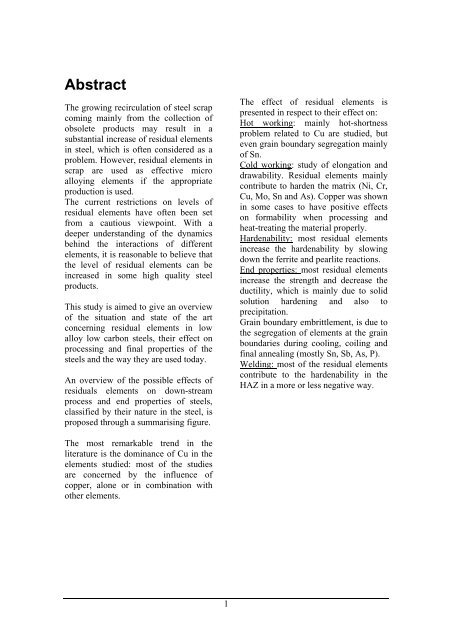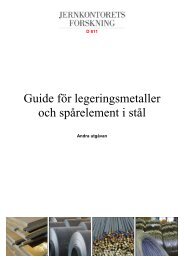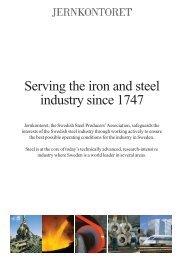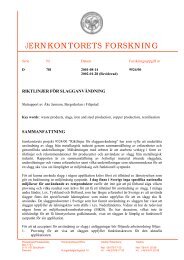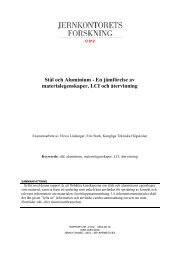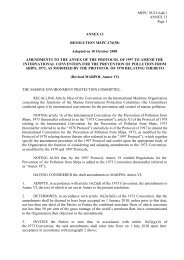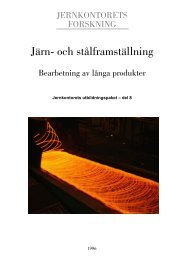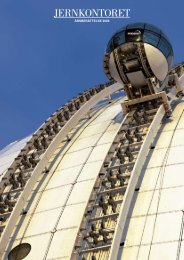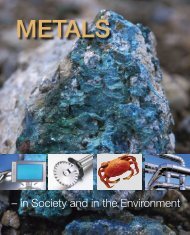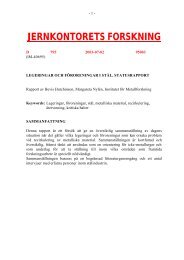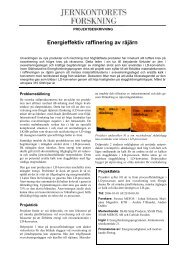Opportunities and dangers of using residual elements ... - Jernkontoret
Opportunities and dangers of using residual elements ... - Jernkontoret
Opportunities and dangers of using residual elements ... - Jernkontoret
Create successful ePaper yourself
Turn your PDF publications into a flip-book with our unique Google optimized e-Paper software.
AbstractThe growing recirculation <strong>of</strong> steel scrapcoming mainly from the collection <strong>of</strong>obsolete products may result in asubstantial increase <strong>of</strong> <strong>residual</strong> <strong>elements</strong>in steel, which is <strong>of</strong>ten considered as aproblem. However, <strong>residual</strong> <strong>elements</strong> inscrap are used as effective microalloying <strong>elements</strong> if the appropriateproduction is used.The current restrictions on levels <strong>of</strong><strong>residual</strong> <strong>elements</strong> have <strong>of</strong>ten been setfrom a cautious viewpoint. With adeeper underst<strong>and</strong>ing <strong>of</strong> the dynamicsbehind the interactions <strong>of</strong> different<strong>elements</strong>, it is reasonable to believe thatthe level <strong>of</strong> <strong>residual</strong> <strong>elements</strong> can beincreased in some high quality steelproducts.This study is aimed to give an overview<strong>of</strong> the situation <strong>and</strong> state <strong>of</strong> the artconcerning <strong>residual</strong> <strong>elements</strong> in lowalloy low carbon steels, their effect onprocessing <strong>and</strong> final properties <strong>of</strong> thesteels <strong>and</strong> the way they are used today.An overview <strong>of</strong> the possible effects <strong>of</strong><strong>residual</strong>s <strong>elements</strong> on down-streamprocess <strong>and</strong> end properties <strong>of</strong> steels,classified by their nature in the steel, isproposed through a summarising figure.The effect <strong>of</strong> <strong>residual</strong> <strong>elements</strong> ispresented in respect to their effect on:Hot working: mainly hot-shortnessproblem related to Cu are studied, buteven grain boundary segregation mainly<strong>of</strong> Sn.Cold working: study <strong>of</strong> elongation <strong>and</strong>drawability. Residual <strong>elements</strong> mainlycontribute to harden the matrix (Ni, Cr,Cu, Mo, Sn <strong>and</strong> As). Copper was shownin some cases to have positive effectson formability when processing <strong>and</strong>heat-treating the material properly.Hardenability: most <strong>residual</strong> <strong>elements</strong>increase the hardenability by slowingdown the ferrite <strong>and</strong> pearlite reactions.End properties: most <strong>residual</strong> <strong>elements</strong>increase the strength <strong>and</strong> decrease theductility, which is mainly due to solidsolution hardening <strong>and</strong> also toprecipitation.Grain boundary embrittlement, is due tothe segregation <strong>of</strong> <strong>elements</strong> at the grainboundaries during cooling, coiling <strong>and</strong>final annealing (mostly Sn, Sb, As, P).Welding: most <strong>of</strong> the <strong>residual</strong> <strong>elements</strong>contribute to the hardenability in theHAZ in a more or less negative way.The most remarkable trend in theliterature is the dominance <strong>of</strong> Cu in the<strong>elements</strong> studied: most <strong>of</strong> the studiesare concerned by the influence <strong>of</strong>copper, alone or in combination withother <strong>elements</strong>.1


